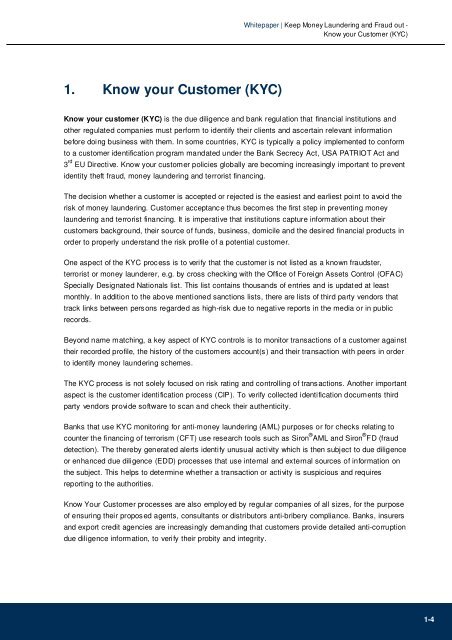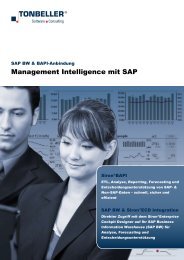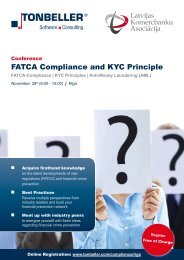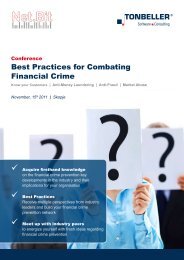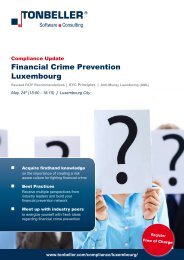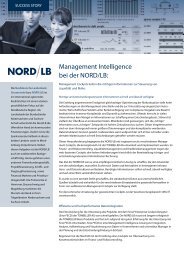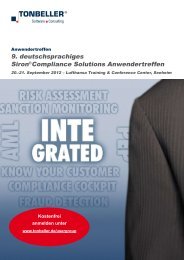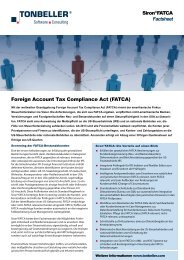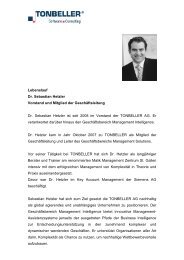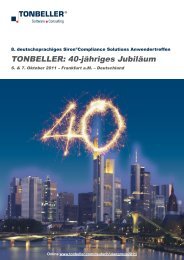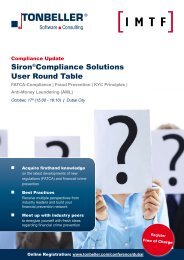Keep Money Laundering and Fraud out - TONBELLER® AG
Keep Money Laundering and Fraud out - TONBELLER® AG
Keep Money Laundering and Fraud out - TONBELLER® AG
You also want an ePaper? Increase the reach of your titles
YUMPU automatically turns print PDFs into web optimized ePapers that Google loves.
1. Know your Customer (KYC)<br />
Whitepaper | <strong>Keep</strong> <strong>Money</strong> <strong>Laundering</strong> <strong>and</strong> <strong>Fraud</strong> <strong>out</strong> -<br />
Know your Customer (KYC)<br />
Know your customer (KYC) is the due diligence <strong>and</strong> bank regulation that financial institutions <strong>and</strong><br />
other regulated companies must perform to identify their clients <strong>and</strong> ascertain relevant information<br />
before doing business with them. In some countries, KYC is typically a policy implemented to conform<br />
to a customer identification program m<strong>and</strong>ated under the Bank Secrecy Act, USA PATRIOT Act <strong>and</strong><br />
3 rd EU Directive. Know your customer policies globally are becoming increasingly important to prevent<br />
identity theft fraud, money laundering <strong>and</strong> terrorist financing.<br />
The decision whether a customer is accepted or rejected is the easiest <strong>and</strong> earliest point to avoid the<br />
risk of money laundering. Customer acceptance thus becomes the first step in preventing money<br />
laundering <strong>and</strong> terrorist financing. It is imperative that institutions capture information ab<strong>out</strong> their<br />
customers background, their source of funds, business, domicile <strong>and</strong> the desired financial products in<br />
order to properly underst<strong>and</strong> the risk profile of a potential customer.<br />
One aspect of the KYC process is to verify that the customer is not listed as a known fraudster,<br />
terrorist or money launderer, e.g. by cross checking with the Office of Foreign Assets Control (OFAC)<br />
Specially Designated Nationals list. This list contains thous<strong>and</strong>s of entries <strong>and</strong> is updated at least<br />
monthly. In addition to the above mentioned sanctions lists, there are lists of third party vendors that<br />
track links between persons regarded as high-risk due to negative reports in the media or in public<br />
records.<br />
Beyond name matching, a key aspect of KYC controls is to monitor transactions of a customer against<br />
their recorded profile, the history of the customers account(s) <strong>and</strong> their transaction with peers in order<br />
to identify money laundering schemes.<br />
The KYC process is not solely focused on risk rating <strong>and</strong> controlling of transactions. Another important<br />
aspect is the customer identification process (CIP). To verify collected identification documents third<br />
party vendors provide software to scan <strong>and</strong> check their authenticity.<br />
Banks that use KYC monitoring for anti-money laundering (AML) purposes or for checks relating to<br />
counter the financing of terrorism (CFT) use research tools such as Siron ® AML <strong>and</strong> Siron ® FD (fraud<br />
detection). The thereby generated alerts identify unusual activity which is then subject to due diligence<br />
or enhanced due diligence (EDD) processes that use internal <strong>and</strong> external sources of information on<br />
the subject. This helps to determine whether a transaction or activity is suspicious <strong>and</strong> requires<br />
reporting to the authorities.<br />
Know Your Customer processes are also employed by regular companies of all sizes, for the purpose<br />
of ensuring their proposed agents, consultants or distributors anti-bribery compliance. Banks, insurers<br />
<strong>and</strong> export credit agencies are increasingly dem<strong>and</strong>ing that customers provide detailed anti-corruption<br />
due diligence information, to verify their probity <strong>and</strong> integrity.<br />
1-4


